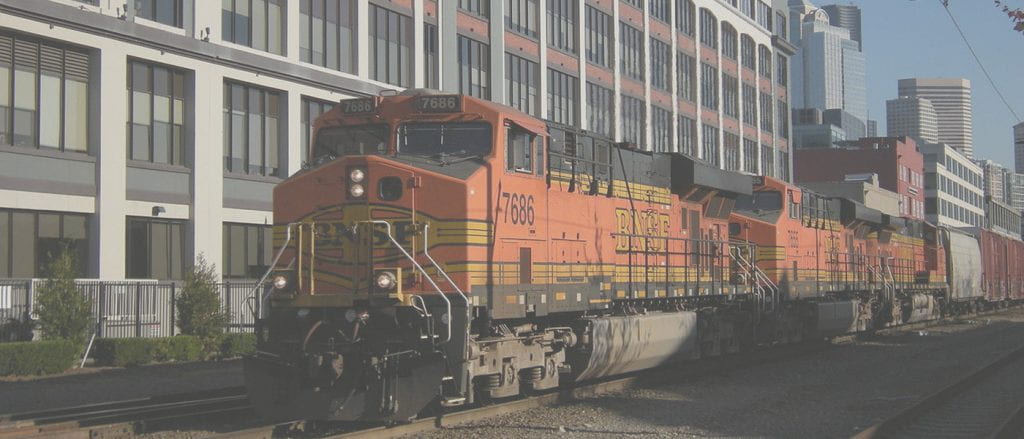
What is APOLLO—Train Study?
Apollo is a research project studying the air quality implications of coal and diesel trains. Our research focused on answering the question: Do coal and diesel trains cause unhealthy air? This project began in the summer of 2013 with research in Seattle, Washington, and the Columbia River Gorge, Washington. In summer 2014, we conducted additional research in the Columbia River Gorge, Washington. In summer 2015, we carried out research in Bellingham, Washington.
What does APOLLO stand for?
APOLLO stands for Air Pollution On Lines… Well, the students working on the project liked the name Apollo, but we could never finish the acronym. Even so, the name Apollo stuck. It isn’t an acronym.
Research goals and experimental methods
Our research questions are:
- What is the exposure to size-segregated particulate matter (PM), both diesel PM and airborne coal dust, of people living near the rail lines?
- Can we estimate the current and potential future exposure to size-segregated PM for people living near the rail lines?
- What are the emissions from diesel trains? How do the observed emission factors compare with published data?
- Do coal trains emit coal dust into the air?
To do this, we measured size–segregated particulate matter (PM1, PM2.5 and PM10—PM less than 1 micron (µ), 2.5 µ and 10 µ in diameter, respectively), CO2 and meteorology, and used a motion-activated camera to capture video of each train for identification.
Research site locations
- Summer 2015
- Bellingham, Washington, USA
- Summer 2014
- Columbia River Gorge, between the towns of Lyle and Dallesport, Washington, USA
- Summer 2013
- Blue Ridge neighborhood in northwest Seattle, Washington, USA
- Columbia River Gorge, near Lyle, Washington, USA
Main findings
Summer 2014, Columbia River Gorge, Washington
We measured PM1, PM2.5, black carbon (BC) and CO2 during 367 train passages (train events) in the Columbia River Gorge. In four coal train events, which we call “super-dusters,” the coal dust emissions led to visible dust plumes and the highest PM2.5 concentrations observed in our study. (See the “Videos of coal trains” section below to view videos of super-dusters.) But nearly all coal trains appeared to generate some degree of coal dust (PM2.5) based on the following evidence:
- Statistically higher peak PM2.5 concentrations during passage of coal trains compared to freight trains. The PM2.5 peaks during a coal train passage are 78% higher than those during a freight train passage.
- The fact that most freight trains (52%) show a good correlation between PM2.5 and CO2, whereas very few coal trains (16%) show this relationship.
- The BC/PM2.5 fraction is statistically higher for freight trains compared to coal trains.
- The PM1/PM2.5 fraction is statistically higher during passage of freight trains compared to coal trains.
Summer 2013, Seattle and Columbia River Gorge, Washington
We measured the PM1 emission factors for over 450 trains at two sites in Washington State and the resulting PM2.5 exposure (µ gram/m3). For 84 of these trains, we also measured the black carbon emission factors. We found that:
- Living very close to the tracks in Blue Ridge increases one’s exposure to diesel PM by about 6.7 µ gram/m3. This level of exposure is comparable to that in the most industrial parts of Seattle (e.g., Duwamish Valley).
- There is a significant increase in large particles (>1 µm) in the air after coal trains passed by, compared with other train types. This result suggests that these trains are emitting coal dust into the atmosphere during transit.
- An increase in train traffic will increase the diesel PM exposure for residents along the rail lines. A 50% increase in rail traffic will put some neighborhoods at risk of exceeding US air quality standards.
Peer-reviewed publications
2015
Diesel particulate matter and coal dust from trains in the Columbia River Gorge, Washington State, USA, by D.A. Jaffe, J. Putz, G. Hof, G. Hof, J. Hee, D.A. Lommers-Johnson, F. Gabela, J.L. Fry, B. Ayres, M. Kelp and M. Minsk, Atmospheric Pollution Research 6, 946–952, doi: 10.1016/j.apr.2015.04.004. Click here to read the full article.
2014
Diesel particulate matter emission factors and air quality implications from in-service rail in Washington State, USA, by D.A. Jaffe, G. Hof, S. Malashanka, J. Putz, J. Thayer, J.L. Fry, B. Ayres and J.R. Pierce, Atmospheric Pollution Research 5, 344–351, doi: 10.5094/APR.2014.040. Click here to read the full article.
Videos of coal trains
The videos we have included are of coal train events we call “super-dusters,” events with visible dust plumes and the highest PM2.5 concentrations observed in our 2014 study in the Columbia River Gorge, Washington.
- July 27, 2014, Columbia River Gorge. Click here to view the video.
- August 7, 2014, Columbia River Gorge. Click here to view the video.
Photos of the coal train study
Public presentations
- August 2015
- All Aboard! Three Studies on Diesel and Coal Dust from Trains in Washington State by Dan Jaffe. Click here to see the presentation slides.
- November 2013
- Do coal and diesel trains make for unhealthy air? by Dan Jaffe, Sofya Malashanka, Greg Hof, Jeff Thayer and Justin Putz. This presentation includes useful information for laypeople about air quality impacts on health. Click here to see the presentation slides.